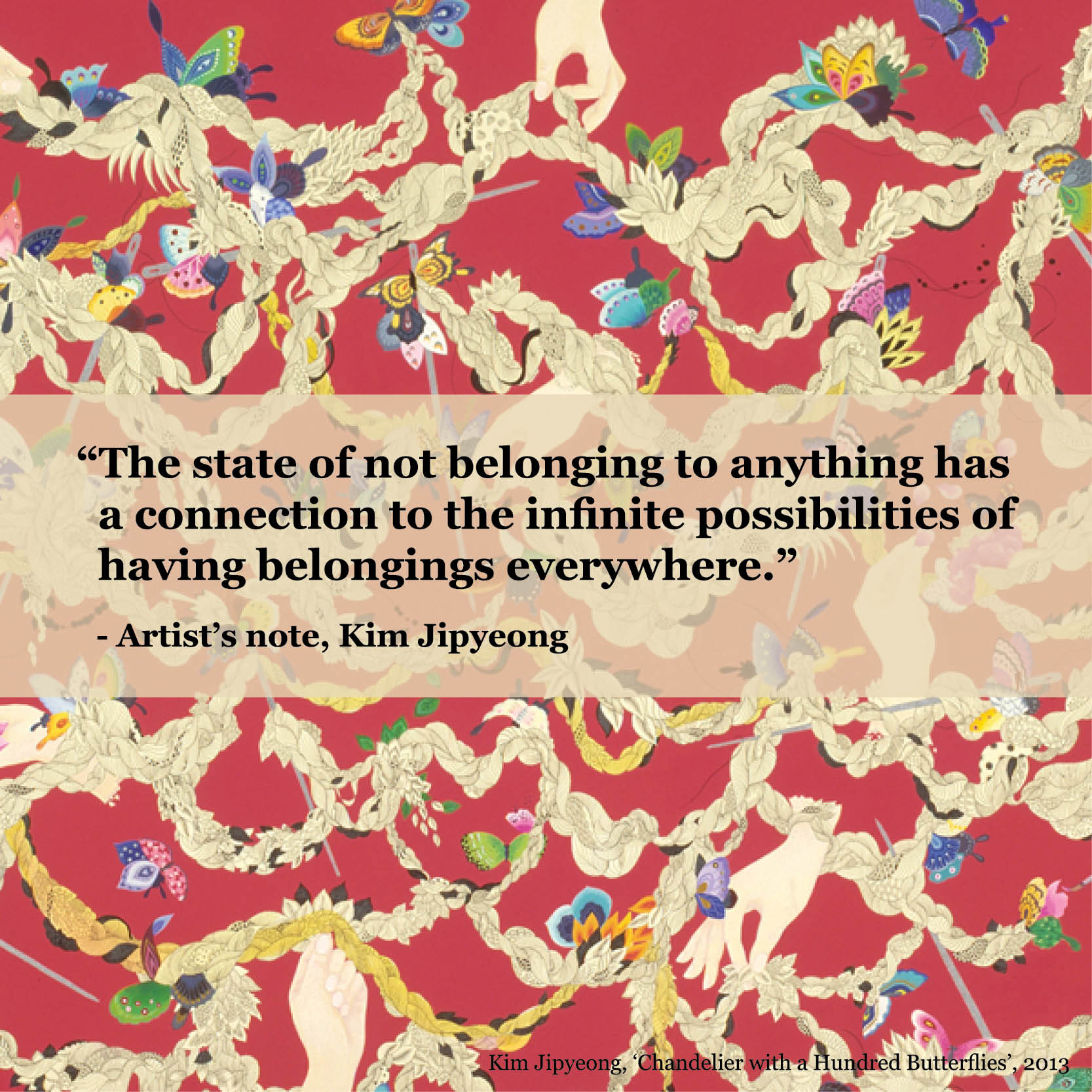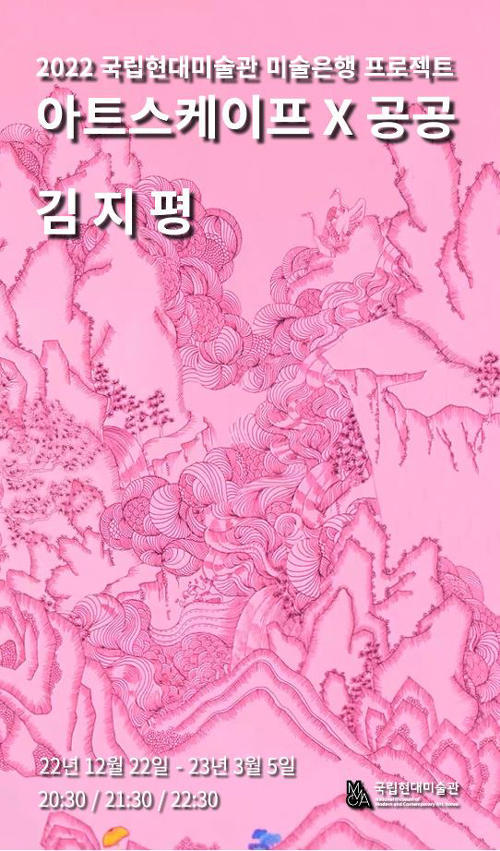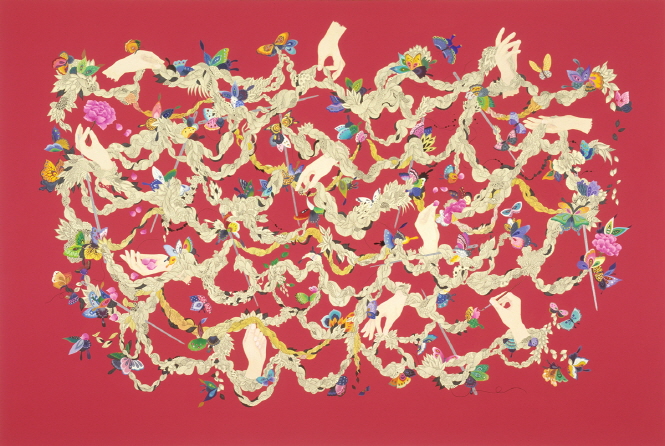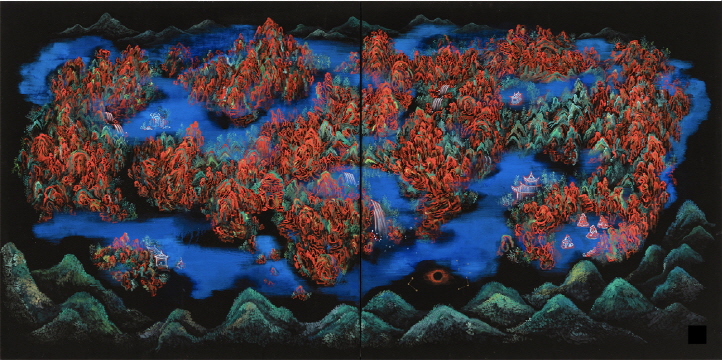
Kim Jipyeong, 'Blood and wine,' 2017, Cinnabar on Korean paper, 88 x 116 cm.
Korean traditional painting has undergone various changes in response to the country’s tumultuous history. However, it wasn’t until the mid-1990s that the genre’s medium, technique, and subject matter began to undergo a rapid transformation. The genre, which had been trapped by the notion of preserving its traditions, began to think outside the box, accepting acrylic paint instead of brush ink, adapting to other genres such as installation and video, and covering radical ideas touching on topics such as popular culture.
In the 2000s, contemporary works that adapted the forms of traditional Korean paintings or vice versa began to receive widespread attention in the local art scene and the art market. A number of artists achieved phenomenal success by combining Korean traditions with contemporary art. One of these artists was Kim Jipyeong (b. 1976).

Kim Jipyeong, 'Still Life,' 2010, acrylic on canvas, 180x70cm.
Kim Jipyeong worked as an artist under the name Kim Jihye before 2013, when she became widely known as a painter who brought a fresh perspective to traditional Korean paintings such as Chaekgeori, a genre of still-life painting of books and stationery, Munjado, paintings of Chinese characters, and Hwajodo, paintings of flowers and birds. Kim was especially known for her vibrant Chaekgeori paintings. In 2007, due to her popularity, she was able to hold a large solo exhibition at the Insa Art Center in Seoul and paint over 500 Chaekgeori works.
However, in an effort to expand her artistic horizons, Kim broke away from Chaekgeori paintings in 2013. She continued her art career under the new artist name Kim Jipyeong and expanded her practices from drawing traditional paintings to creating works that take a different perspective on the theories and medium of traditional Eastern paintings. Since 2013, Kim has conducted extensive research on folk tales, myths, travel records, and ancient literature to bring hidden stories and neglected traditions to light through her works.
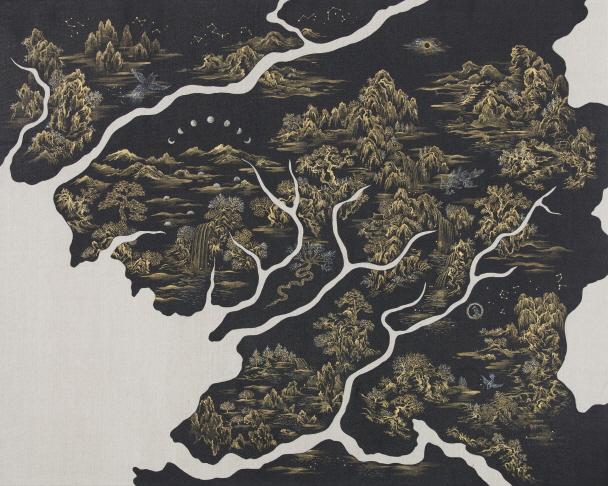
Kim Jipyeong, 'Pyeonan-Do,' 2014, Ink and gold leaf on linen canvas, 130 x 160 cm.
The art world of the Joseon Dynasty (1392–1910) was founded on Confucian principles and was dominated by men. Kim brings forward the stories of women, sexual desires, shamanism, Buddhism, and outsiders, all of which were considered taboo in traditional Korean culture, and presents them from a contemporary perspective.
However, Kim does not simply place mainstream traditions on the opposite side of these once nonmainstream cultures. This binary opposition, in the artist’s view, perpetuates stereotypes and prejudices that impede the development of contemporary Korean art. To shed light on the untold stories of the underrepresented cultures, Kim considers both essential Eastern values by elevating the obscured side to the same level.

Kim Jipyeong, '2020,' 2020, Ink and color on paper, 93 x 106 cm.
In a similar vein, Kim Jipyeong questions the excessively contemporary interpretation of tradition and intentionally returns to the past to apply anachronistic ideas in her works. This is because the idea of “anachronism” excludes everything except the belief in “contemporaneity,” which is the best way for an artist to doubt the present.
Kim’s works that use Janghwang (粧䌙) are some good examples. Janghwang is an ornamental accessory for folding screens or scrolls, and the names of each part of Janghwang were usually compared to women’s clothing. The part above the paintings was known as the Jeogori, or the upper garment of the hanbok. The section below was known as the Chima, or skirt, and the sidebands were called sleeves. The artist removes the paintings from the center of the folding screens or scrolls and replaces them with these ornaments.

Installation view of 'Neungpamibo (능파미보(凌波微步)-숙선, 호연재, 옥봉, 매창, 사주당, 금원, 청창, 난설헌, 운초, 빙허각’) at "Past. Present. Future," SongEun, Seoul. Photo by Aproject Company.
As for the scroll series, Kim personified the main female characters from gothic novels, such as Bertha, Carmilla, Rebecca, and Lady Castiglione. In the artwork entitled Neungpamibo (凌波微步) (2019), a ten-paneled folding screen depicts ten female scholars of the Joseon Dynasty. In these works, the main paintings are absent and have been replaced by various pieces of silk with different patterns and colors that match each female figure. Here, Kim overturns the relationship between the Janghwang and the painting, revealing the stories of women devalued in history.

Kim Jipyeong, 'Gwangbae (光背),' 2020. Gold power and color on paper, 160x240cm.
Kim’s highly decorative paintings, which borrow the forms of traditional Buddhist and shamanic paintings, are another example. The artist observes that the divine depicted in these religious paintings is always highly decorated. In works such as Gwangbae (光背) (2020), she leaves the space where divinity should be empty, leaving the painting with only extravagant decorations. The artist depicts the absence of divinity neither positively nor negatively. The empty space could signify either a God who has left the seat or a God who has not yet arrived. Thus, the artist does not point in a particular direction but rather faces the absence.
Thus, the artist Kim Jipyeong uses techniques, forms, and materials that have been undervalued by mainstream traditions, such as touching on topics related to female artists, shamanic paintings, Buddhist paintings, or forgotten artworks that exist only in records. The artist breaks away from conventional methods and tells stories from the past and present from a unique perspective.

Artist Kim Jipyeong. Courtesy of the artist.
With the exhibition Brilliant Texture (Gana Art Contemporary, Seoul, Korea) in 2013, she began applying new interpretations and viewpoints to traditional Korean paintings. Since then, she has held solo exhibitions at Art Company (2015, Seoul, Korea), Hapjungjigu (2017, Seoul, Korea), and Gallery Meme (2019, Seoul, Korea). Kim also participated in numerous group exhibitions, including those at the Seoul Museum of Art (Seoul, Korea), Art Space Pool (Seoul, Korea), Fengxian Museum (Shanghai, China), Lee Ungno Museum (Daejeon, Korea), and Indipress Gallery (Seoul, Korea). Kim Jipyeong was one of the twenty artists selected for the 21st SongEun Art Award (SongEun Art and Cultural Foundation, Korea). Her work is included in the collections of the Seoul Museum of Art (Seoul, Korea), MMCA ArtBank (Gwacheon, Korea), Gana Art Gallery (Gwacheon, Korea), Hana Bank (Seoul, Korea), Amorepacific Museum (Seoul, Korea), and Hankook Chinaware (Chungju, Korea).




